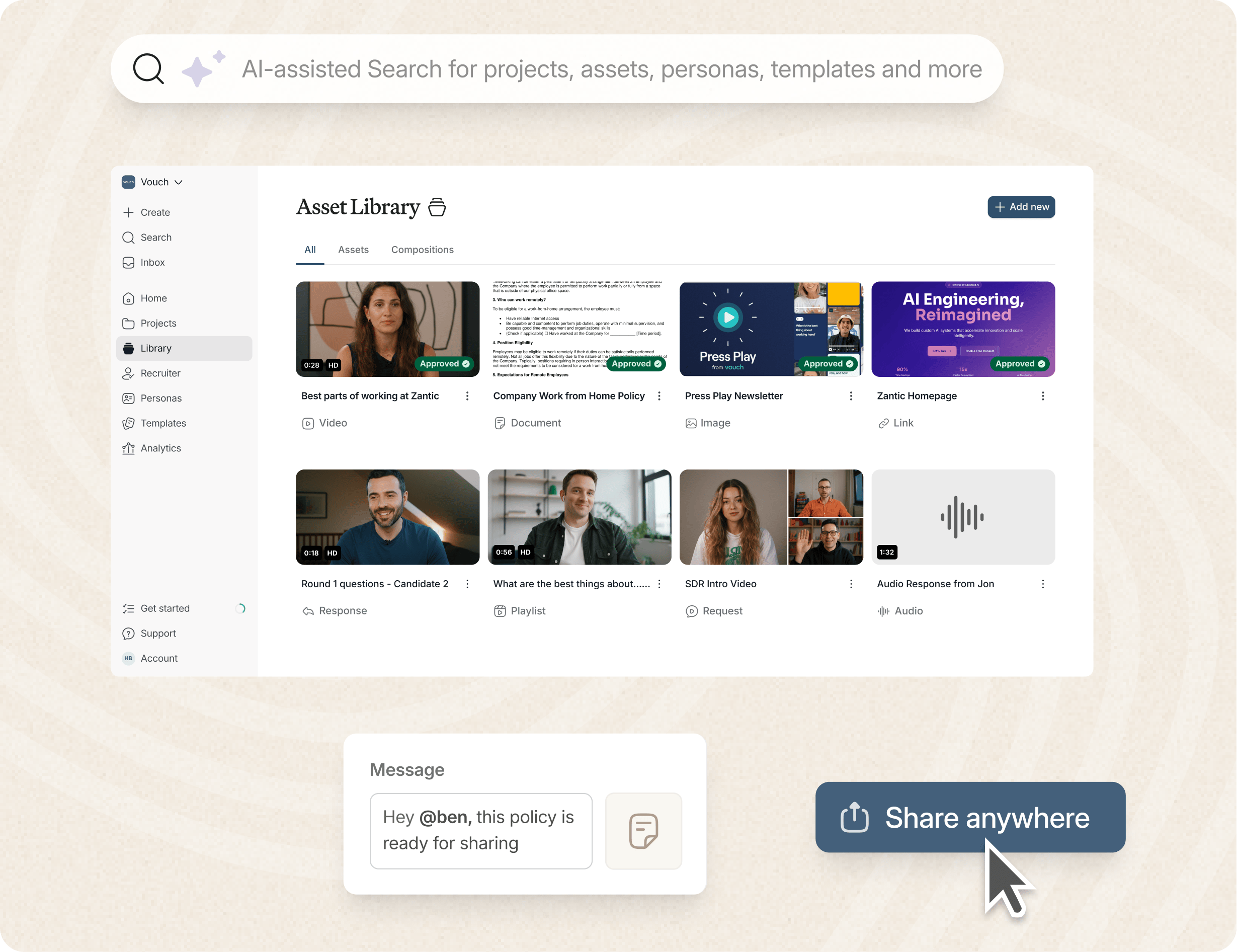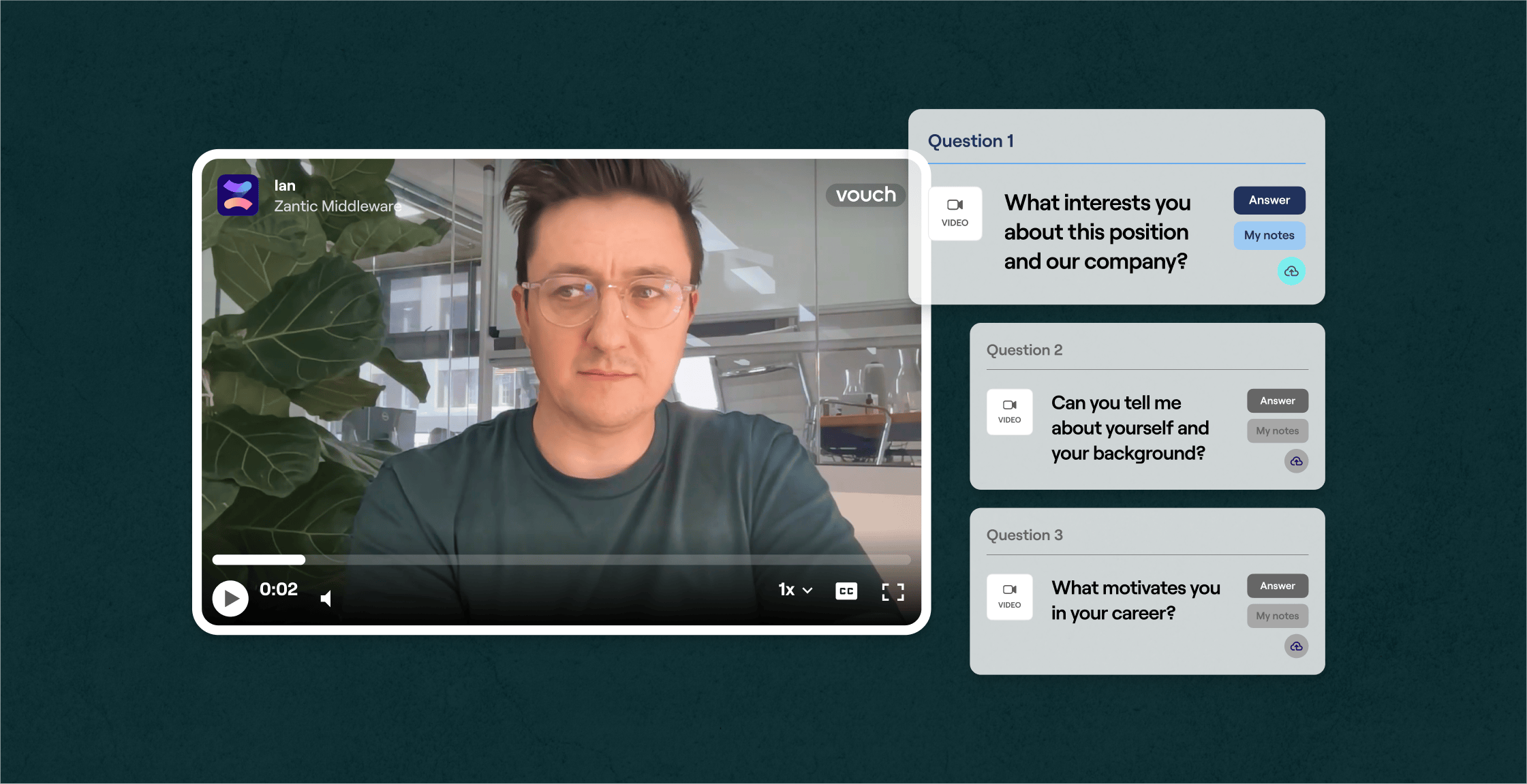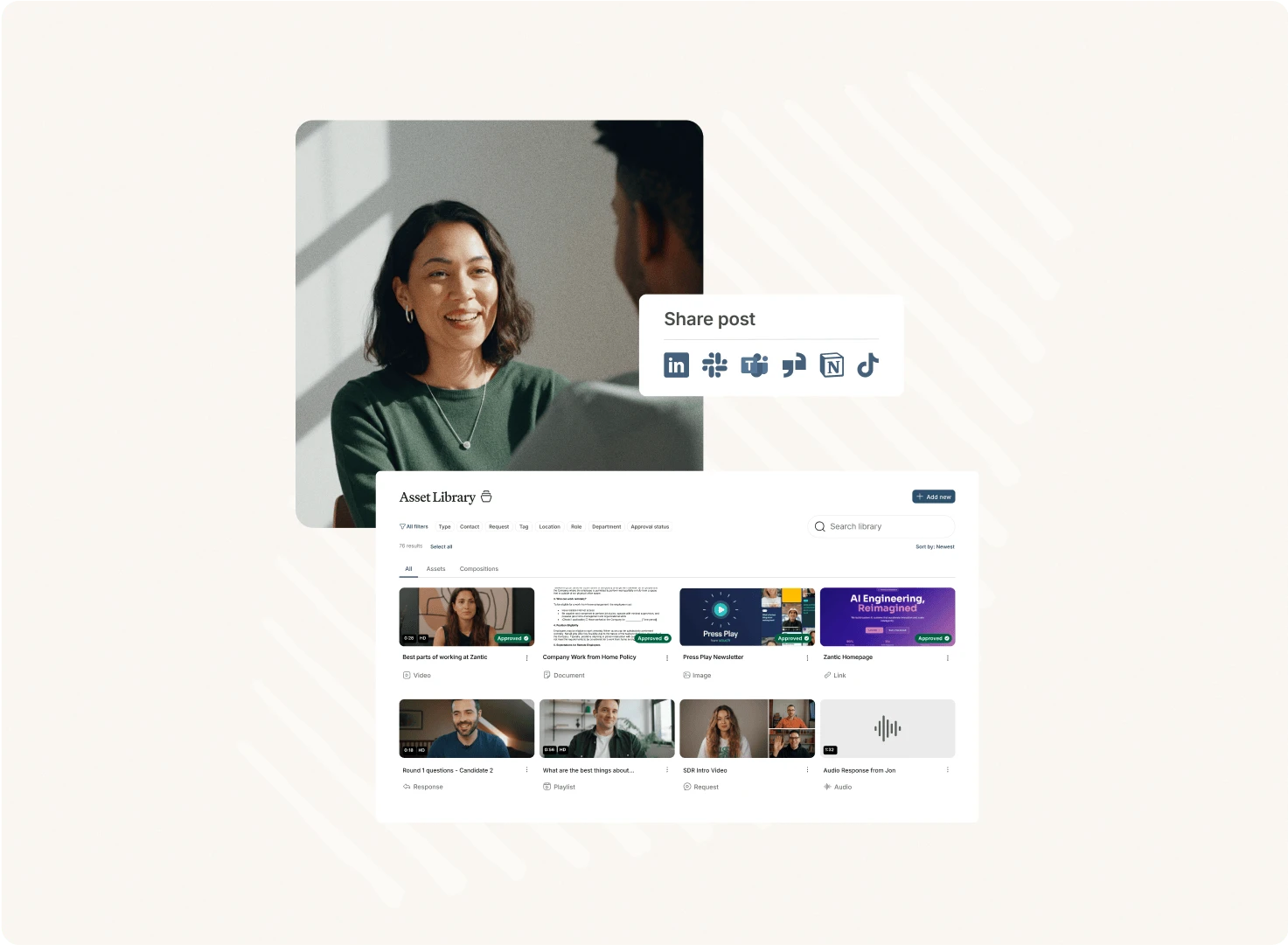Did you know that in 2026, companies with strategic hiring processes experience 21% greater profitability?
Strategic hiring is more than just attracting top talent in the short term - it's a strategy to build your employer brand for long-term talent acquisition success so your business attracts the ideal candidates in the future, too.
Let's get started.
What Is A Strategic Hire Exactly?
Strategic hiring, also called strategic recruitment, is a comprehensive approach to finding, interviewing, and hiring the best people for your unique company - and, importantly, your company culture.
Here are the benefits of following effective recruitment strategies:
- Improved Quality of Hire
- Reduced Time-to-Fill
- Cost Savings
- Better Employee Retention
- Increased Employee Engagement
- Enhanced Employer Brand
- Alignment with Business Goals
- Adaptability and Innovation
- Competitive Advantage
The AI-enabled workspace for talent teams.
- Unified workspace for talent teams
- Accelerate hiring with AI tools
- Auto-generate polished hiring and employer brand content
- Easily repurpose assets across all channel

What Are The 7 Steps For A More Strategic Hire?
Implementing strategic recruitment efforts requires a systematic and step-by-step approach. By following a well-defined plan, you can attract, select, and hire the best candidates.
Step 1: Grow Your Employer Brand
Building a good employer brand is an integral part of the strategic hiring process, from attracting to retaining employees. Your employer brand tells people about your company's culture, beliefs, and positive experiences.
To build a strong employer brand, ensure your messages align with your values, share success stories from your employees, and talk about what makes your culture special. A strong employer brand helps you build your talent pipeline and can give you a massive edge over competitors.
Step 2: Clearly Define Your Hiring Goals
The first step in strategic hiring is to set clear hiring goals, ensure that the hiring process aligns with business goals, and identify the necessary skills for candidates. This will help you focus your recruitment efforts.
It's also important to consider how each job will impact your organization and the skills that will be required. Addressing any gaps in your team will enable you to attract and hire top talent, setting you up for success.
Step 3: Develop a Talent Acquisition Strategy
After setting hiring goals, the next step is to devise a plan for finding good candidates. This includes making a strategic plan for hiring people, including company branding, methods for finding candidates, and recruitment timelines.
This is where your employer brand really shines, and you can use video tools like Vouch to better attract the right candidates across social media channels like LinkedIn, reaching a wider candidate pool and reaching both active and passive job seekers.
Step 4: Craft Better Job Descriptions
Writing clear, concise job descriptions is a crucial part of strategic hiring. These job titles are more than just a "list of duties and requirements"; they're also chances to find the best candidates and show them what it's like to work for your company.
One way to improve your job descriptions is to use candidate personas to better focus on what "your ideal candidates are looking for." If you're new to personas and need any help, we could suggest contacting your marketing team, as they likely use personas every single day!
Step 5: Create A Remarkable Candidate Experience
Providing a great candidate experience is everything when it comes to long-term hiring success. Remember, if you have 100 applicants for 1 job, 99 people might be perfect for another role in your company if they don't get this one.
Communication and feedback are key, and you can find a little guide here on Improving Your Candidate Relationship Management.
Step 6: Simplify Onboarding for New Hires
Simple onboarding is critical to strategic recruitment. During the onboarding process, help new employees get used to their new jobs by giving them the tools, training, and support they need - without overwhelming them.
A guide or a buddy to help them is also a great strategy that goes a long way during onboarding to boost happiness, retention, and long-term success.
Step 7: Leverage Data-Driven Tools
New platforms and tools can help with the candidate screening and hiring decision process. ATS (applicant tracking systems) make life easier for hiring managers.
Modern video tools like Vouch can also rapidly improve recruiting and onboarding by making personalized videos that welcome new employees, introduce them to key coworkers, and dive into your company culture.
What Companies Use Strategic Hiring Processes?
Several well-known companies implement a Strategic Hiring process, this means they align their recruitment with long-term business goals, invest in employer branding, and focus on acquiring talent that contributes to innovation and sustainability.
Here are examples of companies that are recognized for using strategic hiring strategies:
1. Google
Key Strategies:
- Structured interviews with predefined scoring rubrics.
- Data-driven hiring using internal analytics.
- Talent pools built for future needs, not just open roles.
Results: Google prioritizes hiring for potential and cultural fit, rather than just current skillsets.
2. Amazon
Key Strategies:
- “Bar Raisers” program to ensure each hire improves team quality.
- Long-term workforce planning with leadership principles.
- Strong focus on mechanisms to reduce hiring bias.
Results: Amazon ensures consistency in hiring quality across all global locations.
3. IBM
Key Strategies:
- Predictive analytics to identify future talent gaps.
- Upskilling existing talent and hiring for evolving tech needs.
- Alignment with digital transformation goals.
Results: IBM’s talent strategy is closely linked to its technology roadmap and global delivery model.
4. Deloitte
Key Strategies:
- Strategic workforce planning based on forecasted client needs.
- Recruitment aligned with industry trends, e.g., AI, sustainability.
- Heavy use of data and assessment platforms.
Results: Deloitte ensures the right talent is in place ahead of client demand.
5. Salesforce
Key Strategies:
- Proactive diversity hiring aligned with core values.
- Strong employer branding and community presence.
- Focus on long-term cultural alignment over short-term skills.
Results: Their strategic hiring fosters a high-retention, value-driven workforce.
6. Unilever
Key Strategies:
- Future-fit leadership pipelines.
- Digital hiring tools, e.g., AI-powered gamified assessments.
- Focus on sustainability and purpose-alignment in hiring.
Results: Unilever ensures their hires are equipped to meet global business and ethical challenges.
7. Netflix
Key Strategies:
- Hiring only “fully formed adults” who can operate with autonomy.
- Prioritizing alignment with their unique culture deck.
- Minimal policy, maximum accountability approach.
Results: Netflix maintains a high-performance culture through disciplined and cultural hiring.
What Are 3 Famous Quotes On Strategic Hiring?
Here are 3 famous quotes on Strategic Hiring that are widely cited and resonate with leaders building high-performance teams:
1. “The secret of my success is that we have gone to exceptional lengths to hire the best people in the world.”
— Steve Jobs
Context:
This quote reflects Jobs’ laser-focus on hiring as a strategic differentiator at Apple. It emphasizes that the quality of talent is not just an HR issue, but the core of business success.
2. “You can’t teach employees to smile. They have to smile before you hire them.”
— Arte Nathan, Former CHRO, Wynn Resorts
Context:
A classic in behavioral hiring, this quote underscores the importance of cultural fit and attitude in strategic recruitment. It encourages leaders to select talent based not just on skills but also on intrinsic traits aligned with the company’s ethos.
3. “I hire people brighter than me and I get out of their way.”
— Lee Iacocca, Former CEO of Chrysler
Context:
Iacocca’s quote gets to the heart of strategic hiring for empowerment and innovation. It reflects the value of surrounding yourself with strong, independent thinkers who elevate the organization by being trusted to lead.
FAQs
What is strategic recruiting?
Strategic recruiting is a proactive way to find and hire good people, ensuring that the hiring fits in with the company's long-term goals.
How can small businesses implement strategic hiring practices?
Small businesses can achieve success by strategically hiring, setting clear hiring goals, and leveraging first-hand sources like employee referrals.
What role does company culture play in strategic hiring?
Company culture is an integral part of strategic hiring because it affects every hiring manager's decision.
How does strategic hiring differ from traditional hiring?
When hiring traditionally, people are usually employed to fill urgent positions, and long-term organizational goals are only sometimes taken into account. Strategic hiring, on the other hand, plans to meet future talent needs.
Conclusion
In today’s competitive business environment, strategic hiring has become essential for organizations aiming to gain a competitive advantage over competitors, new and old.
The strategic hiring process goes beyond the traditional hiring methods, focusing on aligning the recruitment strategy with the company’s strategic plan to secure high-quality candidates who contribute to long-term success - in other words, not just "bums on seats".
Effective strategic hiring practices start with defining clear job descriptions that attract qualified candidates, and this where candidate personas come into play, helping companies identify both active candidates and passive candidates who might not be actively seeking new opportunities but fit the profile of the ideal candidate.
A candidate-centric approach is critical in today to ensure a positive experience throughout the entire process - from candidate sourcing to interview scheduling, and then pre-boarding and onboarding.
Using applicant tracking systems and maintaining candidate communication is also essential to streamline the interview process and enhance candidate satisfaction.
Organizations should also leverage employee referrals, as current employees often recommend quality hires who are a good fit with your company culture.
In summary, to make a strategic hire you must avoid desperate or bad hiring decision, as these can lead to additional costs and misalignment with your organizational goals. Strategic hire strategies ensure that your future talent aligns with your company’s long-term success, and the key to it all is your employer brand and candidate-centric approach at every step of your recruitment process.
Make Better Strategic Hires With Vouch!
Loved by companies like Canva, Nike, Cisco, HubSpot, Amazon, and more, tools like Vouch make leveraging video in your business remarkably easy.
Book a Vouch demo today and chat with a video content marketing expert.
You might also like

Elevate Your Brand Today With Vouch
Discover how Vouch can accelerate talent acquisition while helping you stay on-brand.






